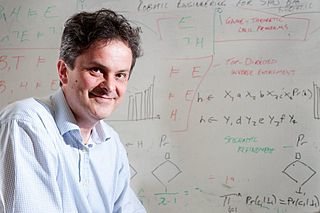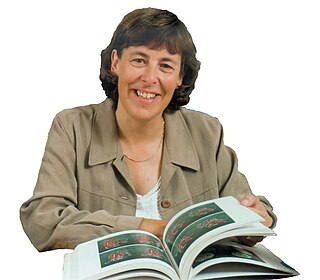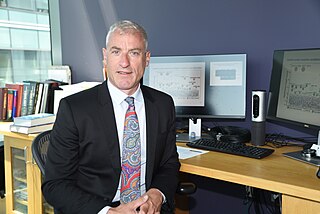
Laboratory robotics is the act of using robots in biology, chemistry or engineering labs. For example, pharmaceutical companies employ robots to move biological or chemical samples around to synthesize novel chemical entities or to test pharmaceutical value of existing chemical matter. Advanced laboratory robotics can be used to completely automate the process of science, as in the Robot Scientist project.

Michael Bruce Eisen is an American computational biologist and the former editor-in-chief of the journal eLife. He is a professor of genetics, genomics and development at University of California, Berkeley. He is a leading advocate of open access scientific publishing and is co-founder of Public Library of Science (PLOS). In 2018, Eisen announced his candidacy U.S. Senate from California as an Independent, though he failed to qualify for the ballot.

Stephen H. Muggleton FBCS, FIET, FAAAI, FECCAI, FSB, FREng is Professor of Machine Learning and Head of the Computational Bioinformatics Laboratory at Imperial College London.

David Baker is an American biochemist and computational biologist who has pioneered methods to predict and design the three-dimensional structures of proteins. He is the Henrietta and Aubrey Davis Endowed Professor in Biochemistry and an adjunct professor of genome sciences, bioengineering, chemical engineering, computer science, and physics at the University of Washington. He serves as the director of the Rosetta Commons, a consortium of labs and researchers that develop biomolecular structure prediction and design software. The problem of protein structure prediction to which Baker has contributed significantly has now been largely solved by DeepMind using artificial intelligence. Baker is a Howard Hughes Medical Institute investigator and a member of the United States National Academy of Sciences. He is also the director of the University of Washington's Institute for Protein Design.

Dame Janet Maureen Thornton, is a senior scientist and director emeritus at the European Bioinformatics Institute (EBI), part of the European Molecular Biology Laboratory (EMBL). She is one of the world's leading researchers in structural bioinformatics, using computational methods to understand protein structure and function. She served as director of the EBI from October 2001 to June 2015, and played a key role in ELIXIR.

Foldit is an online puzzle video game about protein folding. It is part of an experimental research project developed by the University of Washington, Center for Game Science, in collaboration with the UW Department of Biochemistry. The objective of Foldit is to fold the structures of selected proteins as perfectly as possible, using tools provided in the game. The highest scoring solutions are analyzed by researchers, who determine whether or not there is a native structural configuration that can be applied to relevant proteins in the real world. Scientists can then use these solutions to target and eradicate diseases and create biological innovations. A 2010 paper in the science journal Nature credited Foldit's 57,000 players with providing useful results that matched or outperformed algorithmically computed solutions.

Chief Sci
Robot Scientist is a laboratory robot created and developed by a group of scientists including Ross King, Kenneth Whelan, Ffion Jones, Philip Reiser, Christopher Bryant, Stephen Muggleton, Douglas Kell, Emma Byrne and Steve Oliver.
Joseph S. Takahashi is a Japanese American neurobiologist and geneticist. Takahashi is a professor at University of Texas Southwestern Medical Center as well as an investigator at the Howard Hughes Medical Institute. Takahashi's research group discovered the genetic basis for the mammalian circadian clock in 1994 and identified the Clock gene in 1997. Takahashi was elected to the National Academy of Sciences in 2003.

Protein crystallization is the process of formation of a regular array of individual protein molecules stabilized by crystal contacts. If the crystal is sufficiently ordered, it will diffract. Some proteins naturally form crystalline arrays, like aquaporin in the lens of the eye.
Stephen George Oliver is an Emeritus Professor in the Department of Biochemistry at the University of Cambridge, and a Fellow of Wolfson College, Cambridge.

The Turing Institute was an artificial intelligence laboratory in Glasgow, Scotland, between 1983 and 1994. The company undertook basic and applied research, working directly with large companies across Europe, the United States and Japan developing software as well as providing training, consultancy and information services.
Michael Joseph Ezra Sternberg is a professor at Imperial College London, where he is director of the Centre for Integrative Systems Biology and Bioinformatics and Head of the Structural bioinformatics Group.
Mona Singh is a Professor of Computer Science in the Lewis-Sigler Institute for Integrative Genomics at Princeton University.

Sean Whelan is a British-American virologist. He is known for identifying the cellular protein used as a receptor by Ebola virus, for defining the entry pathway that rabies virus uses to enter neurons, and for identifying the ribosome as a possible target for antiviral drugs. In July 2019, he was announced as the new Chair of the Department of Molecular Microbiology at Washington University School of Medicine in St Louis, Missouri. In February 2020, Whelan was recognized as the LGBTQ+ Scientist of the Year 2020 by the National Organization of Gay and Lesbian Scientists and Technical Professionals.

This article presents a detailed timeline of events in the history of computing from 2020 to the present. For narratives explaining the overall developments, see the history of computing.
Karen L. Leach is an American biochemist with extensive drug discovery experience in large pharmaceutical research laboratories. Her expertise in molecular pharmacology, signal transduction and protein kinases, has been used to establish mechanisms of toxicity for therapeutics such as the novel antibiotic linezolid (Zyvox).
A discovery system is an artificial intelligence system that attempts to discover new scientific concepts or laws. The aim of discovery systems is to automate scientific data analysis and the scientific discovery process. Ideally, an artificial intelligence system should be able to search systematically through the space of all possible hypotheses and yield the hypothesis - or set of equally likely hypotheses - that best describes the complex patterns in data.
Emma Byrne is a contemporary British writer and scientist, working in the fields of swearing, artificial intelligence and robotics.
A cloud laboratory is a heavily automated, centralized research laboratory where scientists can run an experiment from a computer in a remote location. Cloud laboratories offer the execution of life science research experiments as a service, allowing researchers to retain full control over experimental design. Users create experimental protocols through a high-level API and the experiment is executed in the cloud laboratory, with no need for the user to be involved.










